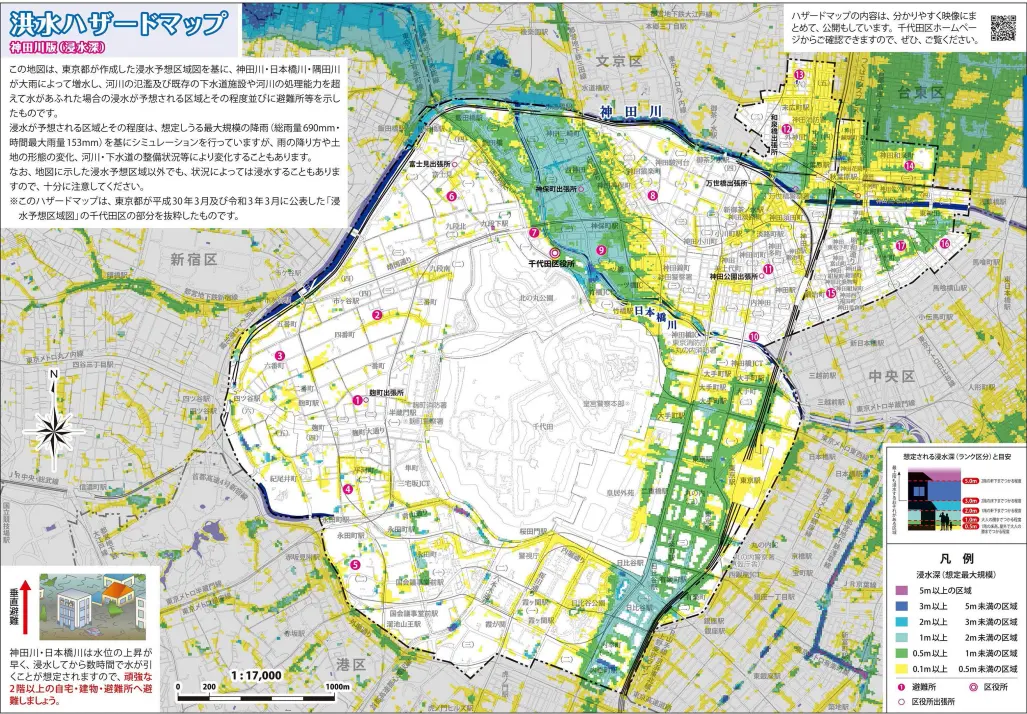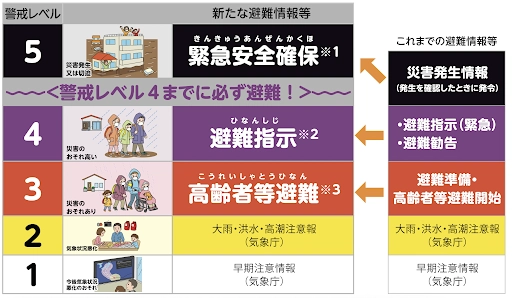1. Prepare in advance for torrential rain!

1.1 Check with hazard maps and evacuation shelter maps
Check the risk of flooding and landslides in and around your home and nearby evacuation centers!
- Multiple evacuation sites
- Multiple evacuation routes
- Areas at high risk of flooding and landslide disasters, etc.
Check your home's risk of flooding, landslides and other disasters
Check the risk of landslides, floods, and storm surges using hazard maps distributed by local governments or available on the web, such as the Hazard Map Portal site operated by the Ministry of Land, Infrastructure, Transport, and Tourism. Check to see if your area is in a "Flood Expected Flood Zone" and the "Duration of Flooding" as well.
Check the inland water hazard map too!
Even if you are far from a river, a rising river or a large amount of rainfall that exceeds the drainage capacity of the river may cause flooding of buildings and land because drainage cannot keep up. It is also important to check the inland water hazard map.
Check the evacuation site!
To ensure that you can evacuate quickly when an evacuation alarm is issued, check the designated emergency evacuation site nearby and confirm a safe evacuation route that avoids possible flooding or landslide areas. It is a good idea to discuss and decide on emergency evacuation sites and communication methods with your family.
Check the hazard map and inland water hazard map!
Hazard Map Portal Site(Japanese)( To external site ):You can find out what kind of disasters can happen around you on the website operated by the Ministry of Land, Infrastructure, Transport, and Tourism.
Check the evacuation area!
Evacuation Site Map:Evacuation sites designated by local governments are listed, and nearby evacuation sites can be found.
1.2Get Prepared for Flooding!
| Preparation for Outside of Home |
|---|
| Reinforce window and shutter |
| Check Emergency Supplies |
| Preparation for Inside of Home |
| Clean Drain |
| Secure water |
Prevent flooding!
Cleaning and removing debris and gravel from gutters and drains can improve water flow and reduce the risk of flooding.Preventing entrances and exits at entrances with sandbags or water bags will help reduce the risk of flooding.
Make the outside of your home safe!
Before heavy rains and windy weather, windows and storm doors should be securely locked and reinforced. If necessary, secure items that may be blown away by the wind so that they do not fly away, or put away inside the house in case of flooding.
Be prepared for any eventuality!
In preparation for water outages, secure drinking water and fill bathtubs with water for daily use. It is also a good idea to put the shatterproof film on the window glass as a safety measure from inside the room and to take down the curtains and blinds in case flying objects fly into the room.
Prepare emergency supplies!
 It is advisable to prepare for a three-day evacuation.
It is advisable to prepare for a three-day evacuation.
- Drinking water and food: dry bread, retort pouch foods, canned foods, crackers, powdered milk, baby bottles, etc.
- Medicines: first aid kit, household medicines, masks, sanitary items, etc.
- Valuables: cash, bankbook, personal seal, health insurance card, ID card, etc.
- Clothing: underwear, towel, sleeping bag, rain gear, military gloves, shoes
- Small items: radio, flashlight, can opener, knife, batteries, rope, matches or lighter, disposable body warmer, writing utensils, water bottle
- Others: emergency hood, helmet, map, etc.


